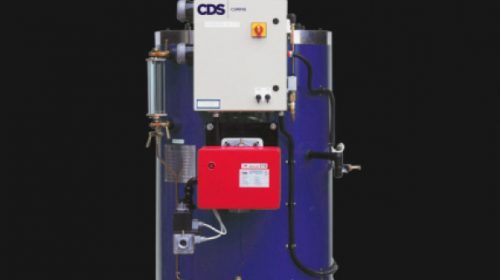Curing Equipment Round Up
CDS INC.
|
|
| VSG-2 Curing System |
 |
| LPHW Curing System |
 |
Engineered to lower the net carbon footprint of finished concrete and economize production, the VSG-2 Curing System features: natural gas, propane or fuel oil firing options; low gas pressure requirements from minimum 20 mbar to maximum 200 mbar; low electrical power requirements; space saving design; virtually silent operation; and, low maintenance design.
The LPHW Curing System uses high efficiency, low/medium pressure hot water boilers and thermal fluids contained within a carefully designed network of pipes linked to a centralized pump to generate accurately controlled radiant heat in applications that require little or no airflow. It runs on natural gas, various fuel oils or LPG, and is shipped in either a pre-modified container or on a skid to save time and cost in set-up and commissioning. The LPHW can be fitted with optional maturity Curing and Control Software, which optimizes the time and energy used in curing various products, in addition to providing detailed operational log for quality control purposes.
Along with the LPHW and VSG-2 Curing models, CDS offers Retractable Canopy Systems to provide portable protection for concrete products during the curing process. Canopies can be custom made to meet the specific production requirements, and are easily deployed using either a freestanding telescopic frame or suspended from a permanent overhead rail structure. The canopies’ complete seal and insulation properties retain heat and help maintain an optimal curing environment. Beyond product and form or bed protection, company engineers note, the canopies provide temperature control and prevent heat loss during the curing cycle; deploy simply and quickly; and, are easy to store. — CDS Inc., 973/641-5663; www.cds-group.co.uk
CureTec


Aggthem Aggregate Heating Systems for sand & gravel bins enable plants to produce concrete at sub-zero temperatures. In contrast to saturated steam-based systems, the hot-dry air (248°F/120°C) Aggtherm equipment uses as a heating medium does not impact the water/cement ratio in the concrete mixture. An additional option for pre-heating mix water equips operators with additional mixture temperature control.
Along with making winter production possible and augmenting stable water/cement ratios, AggTherm Heating Systems afford concrete producers shorter curing time and lower energy costs attributable to their high-performance burners. CureTec also provides direct-fired steam generators with an efficiency of 98 percent; ConCure hot air generators for curing precast elements; and, AllCure, a system combining independently control of hot air and humidity sources. — CureTec/Pathfinder Systems, Holland, Mich., 616/395-8447, 877-49-TIGER; www.pathfindersystem.com
POLARMATIC


Company has engineered concrete curing systems around the carbon dioxide-rich Turbosteam (vapor curing) concept, underscoring its effectiveness for changing products and production loads, wide product variety and flexibility. Low-pressure steam maintains curing chamber/kiln temperature while also supplying the right amount of moisture to keep the humidity level of the environment stable and hydration progressing.
The Polarmatic CureCompact appliance provides a flexible and efficient means for generating an optimum curing environment. Its Turbosteam output is the same heating media generated by the company’s flagship Turbomatic heating system deployed in precast concrete operations worldwide.
CureCompact features a low pressure Turbosteam generator; power rating from 2.6 million to 3.4 million (500 to 1,000 kW) Btu/hour; oil, natural gas or propane fuel options; and, Control Touch screen as standard user interface. Options include PC user interface, Curematic curing control, temperature and humidity transducers for curing chambers/kilns, plus control valves. — Polarmatic North America Ltd., Cincinnati, 603/315-7598; www.polarmatic.com
KRAFT CURING
 |
| Vapor generator |
 |
| Ambient and internal concrete temperature sensors; temperature reading signal receiver; and, AutoCure temperature logging, control software. |
 |
| Vaporware, AutoCure documentation |
 |
Coupled with the company’s signature Vapor Generator equipment, the AutoCure System automatically controls curing temperatures and time for product consistency, lower energy consumption and eliminating cure cycle guesswork. The technology supports wireless, plant-wide communication and enables users to reduce a) cement dosages through curing parameters based on individual mix designs; and, b) energy costs associated with overheating or not utilizing curing products’ heat of cement hydration. Among key AutoCure companion devices:
• MatchCure. Integrated into the system for seamless quality control documentation and curing control, it allows test cylinders to be temperature controlled to match the element being cured.
• Vaporware. Measures, records, prints and stores data. For quality control and general plant management, it connects to the central processor on the vapor generator with Microsoft Windows. Curing data can be displayed and/or printed in color in a graphical or list format; saved on disk or hard-drive; and, accessed internally over company intranet or remotely over a secure connection.
• Wireless probes. Running on batteries carrying one-year charge, the devices measure ambient or internal concrete temperatures and have up to 1,000-ft. line of sight range. Larger operations can be outfitted with multiple receivers. — Kraft Curing, 267/793-1005; www.kraftcuring.com
